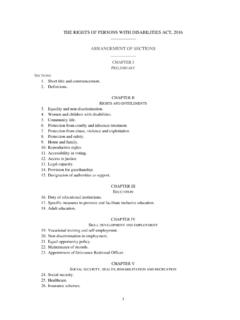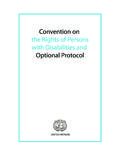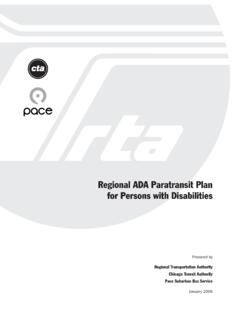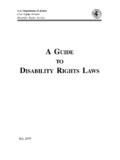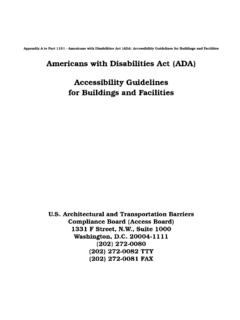Transcription of Best Practices - United Nations
1 best Practices FO R IN CLUD IN G persons W I TH. disabilities . IN A LL AS P E C TS O F DEVELOPMENT. EFFORTS April 2 011. BE ST PRAC T IC E S. FO R I NCL U DIN G PE RSO N S W ITH. DISAB ILIT IE S. I N AL L AS P ECTS O F D E VE LOPME N T. E FFO RTS A p r i l 2 011. United Nations I. DEPARTMENT OF ECONOMIC AND SOCIAL AFFAIRS. The Department of Economic and Social Affairs of the United Nations Secretariat is a vital interface between global policies in the economic, social and environmental spheres and national action. The Department works in three main interlinked areas: (i) it compiles, generates and analyses a wide range of economic, social and environmental data and information on which Member States of the United Nations draw to review common problems and to take stock of policy options; (ii) it facilitates the negotiations of Member States in many intergovernmental bodies on joint courses of action to address ongoing or emerging global challenges; and (iii) it advises interested Governments on the ways and means of translating policy frameworks developed in United Nations conferences and summits into programmes at the country level and, through technical assistance, helps build national capacities.
2 NOTE. The designations employed and the presentation of the material in the present publication do not imply the expression of any opinion whatsoever on the part of the Secretariat of the United Nations concerning the legal status of any country or territory or of its authorities, or concerning the delimitations of its frontiers. The term country as used in the text of this review also refers, as appropriate, to territories or areas. The designations of country groups in the text and the tables are intended solely for statistical or analytical convenience and do not necessarily express a judgement about the stage reached by a particular country or area in the development process. Mention of the names of firms and commercial products does not imply the endorsement of the United Nations . Symbols of United Nations documents are composed of capital letters combined with figures. ACKNOWLEDGEMENTS. The present document was prepared by Dr Rachele Tardi Forgacs and is a collaborative effort by all the colleagues who submitted case studies as well as the many dedicated individuals who provided information and material.
3 These included individuals from Governments, United Nations agencies, Disabled persons Organizations (DPOs), local and international non-governmental organizations (NGOs), and networks, disability advocates and experts from around the world. PHOTO CREDITS. Cover Tree House by Debbie Allaire | WHO Photo Contest Images of Health and Disability 2007 . Page 1, Easy access by Arthur Calasans | WHO Photo Contest Images of Health and Disability 2005 . Page 4 Looking ahead uncertain future by Maria Cierna | WHO Photo Contest Images of Health and Disability 2007 . Page 9, Welded to work by Serge Corrieras | WHO Photo Contest Images of Health and Disability 2005 . ST/ESA/346. Copyright United Nations , 2011. All rights reserved II. Table of Contents Acronyms I. Introduction and methodology II. Criteria of best Practices for mainstreaming disability in development: initial reflections III. Recommendations IV. Case studies 1. AFRICA ETHIOPIA: Organizational learning from attempts to mainstream disability in a small- scale pilot project on access to water, sanitation and hygiene GHANA: Direct child assistance MALI: Initiative for the Inclusion of the Concerns of People with disabilities in the Economic, Social and Cultural Development Programme of the Municipality Of Bougouni TANZANIA: Disability-inclusive child participation UGANDA: Formation of peer support groups of persons with disabilities living with HIV/.
4 AIDS at the sub-county level ZIMBABWE: Disability-Inclusive Livelihoods Protection and Promotion Programme 2. ASIA BANGLADESH, INDIA and PAKISTAN: Awareness-raising and sensitization among all stakeholders on the rights of children with disabilities , with a focus on the right to education INDIA: Right to Information clinics to enable persons with disabilities to access information, services and justice INDONESIA: Building resilience for children with disabilities : strengthening disaster risk reduction (DRR) information delivery NEPAL: Mainstreaming disability in the Association of International NGOs TIMOR-LESTE: Multi-stakeholder partnership for inclusive water, sanitation and hygiene in Timor-Leste UZBEKISTAN: Accessibility, Civic Consciousness, Employment and Social Support for People with disabilities III. 3. AUSTRALIA/OCEANIA AUSTRALIA: AusAID Disability-Inclusive Development Reference Group PAPUA NEW GUINEA: Extending the Australian Development Scholarships programme to persons with disabilities SAMOA: Samoa Inclusive Education Demonstration Program 4.
5 EUROPE KOSOVO: Participatory process in the formulation of a National Disability Action Plan SERBIA: Setting up the Youth Employment Fund SWEDEN: Accessible playgrounds and adventure playgrounds 5. LATIN AMERICA AND THE CARIBBEAN COLOMBIA: Strengthening family-based and self-advocacy organizations to promote the rights of people with intellectual disabilities HAITI: Supporting learners with disabilities NICARAGUA: Participatory management in community-based rehabilitation (CBR) 6. NORTH AMERICA CANADA: Livable and inclusive communities for seniors with disabilities and all citizens: model and tools for actions United STATES OF AMERICA: Combating the unnecessary segregation and isolation of people with disabilities in institutions through private lawsuits to enforce the Americans with disabilities Act 7. MULTI-REGION PROJECTS NEPAL and ZAMBIA: Applying participatory disability rights education to constitution- building NETHERLANDS, ETHIOPIA and INDIA: Thematic Learning Programme on Inclusion of persons with disabilities in Development 8.
6 GLOBAL Comparative study of accessibility criteria and best Practices in 32 building codes and standards from all continents References IV. Acronyms ACLU American Civil Liberties Union ADA Americans with disabilities Act ADD Action on Disability and Development ADS Australian Development Scholarship AIN Association of International NGOs ASB Arbeiter-Samariter-Bund Deutschland ASDOWN Asociaci n Colombiana de S ndrome de Down (Colombian Down Syndrome Association). ASOPIECAD Association of inclusive community education programs Astrid Dellemann AusAID Australian Agency for International Development BESIK Bee, Saneamentu no Igene iha Komunidade (Water, Sanitation and Hygiene in the Community). CAB Children's Advisory Board ( United Republic of Tanzania). CAFOD Catholic Agency for Overseas Development CBM Christoffel-Blindenmission CBR Community-based rehabilitation CCDS Canadian Centre on Disability Studies CDD Centre for Disability and Development CIS Commonwealth of Independent States CRC Convention on the Rights of the Child CRPD Convention on the Rights of persons with disabilities CSID Centre for Services and Information on Disability CSO Civil Society Organization DCDD Dutch Coalition on Disability and Development DDA Department of Disability Affairs DGCS Direzione Generale Cooperazione allo Sviluppo (Italian Ministry of Foreign Affairs General Directorate for Development Cooperation).
7 DID disability inclusive development DPO Organisations of persons with disabilities DRG Disability-Inclusive Development Reference Group DRR disaster risk reduction DSHAC Disability Stakeholders HIV & AIDS Committee (Uganda). DWASH District Water Sanitation and Hygiene DWG Disability Working Group ECDD Ethiopian Centre for Disability and Development ESET Ecole Sup rieure d'Enseignement Technique FELAPH F d ration Locale des Associations de Personnes Handicap es (Local Federation of DPOs). FELASCOM F d ration Locale des Associations de Sant Communautaire (Local Federation of Community Health Associations). FEMAPH F d ration Malienne des Associations de Personnes Handicap es (Mali Federation of DPOs). GAATES Global Alliance on Accessible Technologies and Environments GoE Government of Ethiopia HI Handicap International IA Information-Action IBP International best Practices in Universal Design IE inclusive education II Inclusion International ILO International Labour Organization INEE Inter-agency Network on Education in Emergencies ISO International Standards Organization LCD Leonard Cheshire Disability LCD-SARO Leonard Cheshire Disability South Asia Regional Office V.
8 LIC Livable and Inclusive Community M&E Monitoring and Evaluation MADIPHA Masaka Association of persons with disabilities Living with HIV & AIDS. MDGs Millennium Development Goals MGNREGA Mahatma Gandhi National Rural Employment Guarantee Act MoE Ministry of Education MoLYWCD Ministry of Labour, Youth, Women and children Development (now Ministry of Youth, Women, Children Development and Social Welfare) (Zanzibar). MoU Memorandum of Understanding NAFOPHANU National Forum of People living with HIV & AIDS Networks of Uganda NCDPZ National Council of Disabled persons of Zimbabwe NDAP National Disability Action Plan NDP National Disability Policy NGO non-governmental organization NORAD Norwegian Agency for Development Cooperation NORCAP Norwegian Capacity NUDIPU National Union of Disabled persons of Uganda OCHA Office for the Coordination of Humanitarian Affairs OGG Office for Good Governance (within OPM). OHCHR Office of the High Commissioner for Human Rights ( United Nations ).
9 OPM Office of the Prime Minister OSF Open Society Foundation PIO Public Information Officer PNG Papua New Guinea PRP Protracted Relief Programme PSGs peer support groups PSO Vereniging voor Personele Samenwerking met Ontwikkelingslanden (Association for Staff Cooperation with Developing Countries). PSS Pastoral Social Services RBEC Regional Bureau for Eastern Europe and the Commonwealth of Independent States (UNDP). RHTO Ra'es Hadomi Timor Oan (Timor-Leste Disabled People Organization). RTI Right to Information SAM Society of African Mission SCiT Save the Children in Tanzania SENESE SENESE Inclusive Education Support Services (Samoa). SIDA Swedish International Development Cooperation Agency SNNPR Southern Nations Nationalities and People's Region TASO The AIDS Support Organization TLM The Leprosy Mission TLP Thematic Learning Programme TRAC Target for Resource Assignments from the Core TWGs Technical Working Groups UN/DESA Department of Economic and Social Affairs of the United Nations UNDP United Nations Development Programme UNICEF United Nations Children's Fund VSO Voluntary Service Overseas WA WaterAid WASH Water, Sanitation and Hygiene WEDC Water, Engineering and Development Centre WHO World Health Organization YEF Youth Employment Fund ZAFOD Zambia Federation of the Disabled VI.
10 I. Introduction and Methodology 1. I. Introduction and Methodology The present document has been prepared in response to the request in paragraph 15(b) of General Assembly resolution 65/186, in which the Secretary-General was asked to provide information on best Practices at international, regional, subregional and national levels for including persons with disabilities in all aspects of development efforts . Its aim is the following: (a) To establish a set of initial common criteria based on the Convention on the Rights of persons with disabilities (CRPD) for the identification of what constitutes best Practices in mainstreaming disability;. (b) To present a number of case studies that illustrate these criteria and/or the efforts to implement them in inclusive development;. (c) To present recommendations that can be proposed for the discussion amongst different stakeholders in development and in the disability community leading up to the envisaged high-level meeting of the General Assembly on disability and development in 2013.










